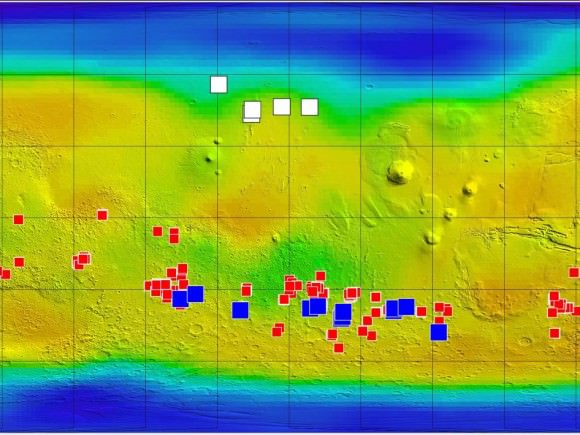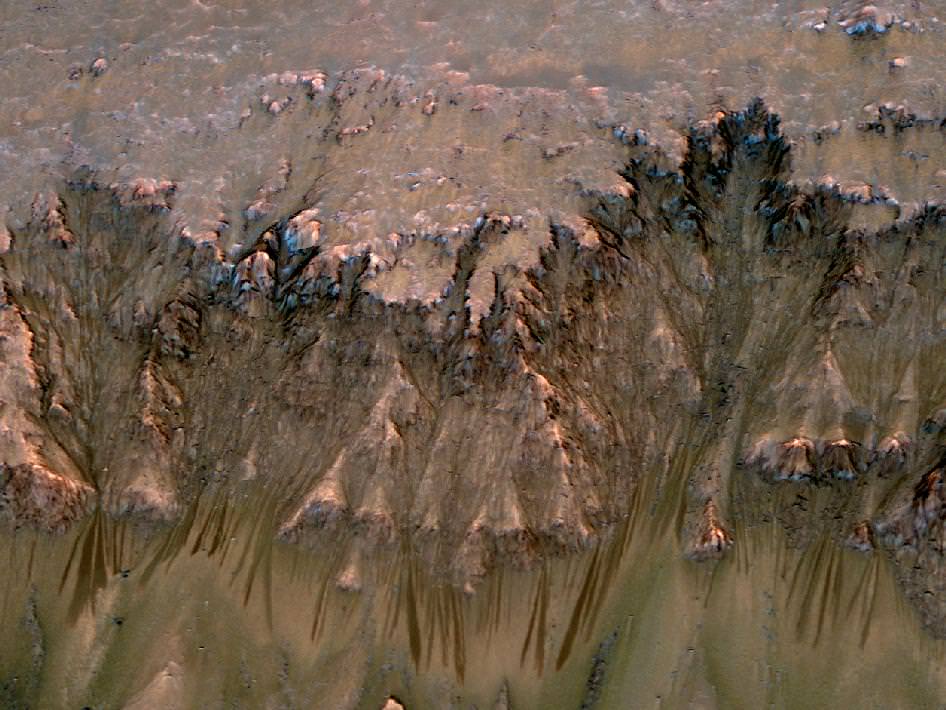[/caption]
In a news conference today, NASA announced discoveries that provide additional evidence of seasonal water flows on Mars. Using data collected by the Mars Reconnaissance Orbiter, the MRO team presented images of dark lines that form on slopes during the martian spring/summer and fade in winter.
During the news conference, HIRISE principal investigator Alfred McEwen (University of Arizona), discussed that these “finger-like” features were found in Mars’ mid-southern latitudes. “The best explanation for these observations so far is the flow of briny water,” he said.
McEwen based his explanation on several key facts: First, salt lowers the freezing point of water (“plain” water would simply stay frozen on Mars) Secondly, the temperature on Mars during these flows ranges from -23 to +27 degrees Celsius, which rules out CO2. While there is significant evidence of flowing water, the team did state that there is no direct detection of water since it evaporates quickly on Mars.
Regarding the dark color of the flows, McEwen added, “The flows are not dark because of being wet, they are dark for some other reason.” McEwen also mentioned that researchers will need to re-create Mars-like conditions in the lab to better understand these flows, stating, “It’s a mystery now, but I think it’s a solvable mystery with further observations and laboratory experiments.”
MRO Project Scientist Richard Zurek (JPL) offered his thoughts as well. “These dark lineations are different from other types of features on Martian slopes,” he said, “and repeated observations show they extend ever farther downhill with time during the warm season.”

What also proves intriguing to the team is that while gullies are very abundant on colder slopes that face the poles, the dark flows discussed in today’s news conference are found on warmer slopes which face the equator.
During the conference, Philip Christensen (Arizona State University) presented a map showing concentrations of “salts” in the same locations that the dark, “finger-like” flows were found.
McEwen reiterated during the Q&A session that the Compact Reconnaissance Imaging Spectrometer for Mars (CRISM), hasn’t detected any signs of water and that laboratory simulations will be necessary to gain a better understanding of these features – basically the team is seeing signs of flowing water, but not the water itself.
If you’d like to learn more about the Mars Reconnaissance Orbiter and today’s announcement, you can visit: http://www.nasa.gov/mro

To see more images related to the new findings, see this link from JPL.
Sources: NASA/JPL News Conference, NASA/JPL News


Careful, the range of temperatures stated wasn’t “23 to 27 ºC”, but “-23 to 27 ºC” (250-300 K) 😉
Cheers!
Thanks for catching that typo. There’s a HUGE difference between -23C and 23C (ALMOST 50 DEGREES!) 😉
Probably invented by NASA to distract from recent stories emerging about how the Kepler spacecraft is not working terribly well but I suppose it is remotely possible as that region of Mars does have some of the best conditions on the planet for flowing water.
Any further south and it would be too cold and just a bit further north and it would be too hot; dry as bone particularly just south of the equator at low elevations.
250-300 Kelvin are the perfect temperatures for flowing salt water but at such low pressure you would think the water would just sublimate, though perhaps the Newton Crater is deep enough to allow liquid water.
Who knows??
Where did you hear that Kepler wasn’t working very well?
Would be nice if the dark stains were biological, is there anything like this at Gale crater?
I don’t know why the dark color, assuming it is real, wouldn’t be wetness. Is that because they can’t see water from a spectra. What else surface modification could it be?
Then again, if it isn’t wetness, biology would be a strong competitor for colors that bleach to the next season. Anything that is broken down by the oxidizing environment would do.
Would be nice if the dark stains were biological, is there anything like this at Gale crater?
For those who want a color key for the third image:
(from the NASA/JPL release)
Blue, at high latitudes north and south, indicates higher concentrations of water ice (deduced from detection of hydrogen); orange designates lowest concentrations. Some hydrogen, possibly in the form of bound water, is close to the surface even at middle latitudes.
The white squares in the northern hemisphere mark locations of small fresh impact craters that exposed water ice close to the surface and validated the neutron spectrometer data.
I don’t think that this is necessarily material for a live newsconference. They found that the side of the crater changes over the course of the seasons, but no direct evidence for water. Seems like they have to do more work and get back to us with more substantial evidence.
I’m surprised that the UT did not present a more balanced view of this news item from NASA. Seems to me like it’s another hyped up science story that needs a lot of follow up investigations.